|
|
|
Sort Order |
|
|
|
Items / Page
|
|
|
|
|
|
|
| Srl | Item |
| 1 |
ID:
143531
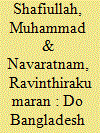

|
|
|
|
|
| Summary/Abstract |
The export-led growth (ELG) hypothesis suggests that there is a strong positive linear relationship between a country’s exports and economic growth. For many years, theoretical and empirical studies have examined the causal relationship between exports and economic growth and found that this relationship is one of interdependence rather than of unilateral causation. The purpose of this article is to empirically re-examine the ELG hypothesis in the context of two small South Asian countries: Bangladesh for the period of 1980–2011 and Sri Lanka for the period of 1984–2011. Using a model that controls for a host of domestic and international factors, this article tests the ELG hypothesis by employing the Auto Regressive Distributed Lag (ARDL) bounds test for cointegration and the Granger causality tests. The empirical results confirm the validity of the ELG hypothesis for both Bangladesh and Sri Lanka.
|
|
|
|
|
|
|
|
|
|
|
|
|
|
|
|
| 2 |
ID:
143529
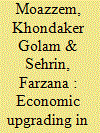

|
|
|
|
|
| Summary/Abstract |
Bangladesh’s success in the global apparel value chain following the expiration of the Multi-Fibre Arrangement in 2005 deserves study to understand how a least developed country can become a major source of apparels within a short period of time. This article shows that even under a quasi-hierarchical governance structure, suppliers in Bangladesh have made significant progress in economic upgrading, particularly process and product upgrading. Competitive pressure linked to the ‘open sourcing’ of apparels has caused leading firms to ease conditionalities on the production process. Preferential access to major markets, timely responses to buyers’ changing demands, favourable policies related to the import of raw materials, production and export of apparels and new labour-related policies have facilitated economic upgrading. Suppliers have accordingly benefited from substantial investment in productive capacity, technological know-how and workers’ skills. Further upgrading would require more investment in firm-level productivity and improvement in physical and social compliance.
|
|
|
|
|
|
|
|
|
|
|
|
|
|
|
|
| 3 |
ID:
143527
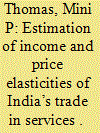

|
|
|
|
|
| Summary/Abstract |
India’s international trade in services benefited immensely from the change in policy stance from import substitution to export promotion in the post-1991 period. Services trade received a further boost when India became signatory to the World Trade Organization (WTO) in 1995. This article aims to estimate the income and price elasticities of India’s services trade during the post-WTO period, using the autoregressive distributed lag (ARDL) approach to cointegration, for the time period starting from 1996–97 Q1 (Quarter 1) to 2011–12 Q4 (Quarter 4). This study finds that the long-run income elasticity of services export is quite high and statistically significant, when the gross domestic product (GDP) of the Organisation for Economic Co-operation and Development countries is taken as proxy for GDP of importing countries. However, the price elasticity of services export is found to be statistically insignificant. In case of services import, both the income and price elasticities of demand are found to be statistically significant, and services import is found to be more responsive to income than relative prices. The implications of the empirical findings for India’s current account deficit are also explored.
|
|
|
|
|
|
|
|
|
|
|
|
|
|
|
|
| 4 |
ID:
143530
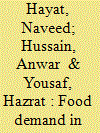

|
|
|
|
|
| Summary/Abstract |
This study analyzes the household food demand followed by projecting the future level of demand of selected food commodity groups in Pakistan. It uses Pakistan Panel Household Survey (PPHS) for the year 2010, conducted by Pakistan Institute of Development Economics (PIDE). The linear approximation/almost ideal demand system (LA/AIDS) model is used to estimate the demand elasticities, while a simple growth model is used for food demand projections. The empirical results reveal that food grains, pulses, ghee, sugar and vegetables are necessities, while milk and meat are luxuries. Pulses and vegetables, ghee and meat, milk and sugar are identified as gross complements on the basis of uncompensated cross-price elasticities. The uncompensated cross-price elasticities of food grains indicate the substitutive relationship between different food items, such as pulses, meat and vegetables. An increase in the household income will induce a substantial expansion in household demand for milk and meat products, but the consumption of these foods will decline if household size grew, ceteris paribus.
|
|
|
|
|
|
|
|
|
|
|
|
|
|
|
|
| 5 |
ID:
143526
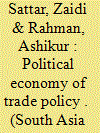

|
|
|
|
|
| Summary/Abstract |
Trade policy within Bangladesh has followed a course of gradual liberalization associated with tariff reduction and rationalization, and removal of protective quantitative restrictions. But the pace of liberalization has varied significantly over different periods depending on the state of the economy or the weight of influence of different actors. To capture this dynamics, in this article, we develop a simple decision theory model to understand how an incumbent government decides upon tariff rationalization strategies. In particular, the role of key stakeholders—consumers, exporters and import substituting industries—is considered, and the collective action issues faced by each group are examined to understand how incumbent governments will respond to their relative influence. Two principle inferences are drawn from this analysis. First, incumbent governments are more likely to facilitate tariff rationalization episodes in times of economic or political crisis. Second, if the economy is not in a state of crisis and consumers suffer from the acutest form of collective action problem, then one can expect that tariff rationalization momentum will be slow or non-existent as long as import substituting industries have equal or more policy clout than exporters. These inferences are then examined in the context of trade policy developments in Bangladesh.
|
|
|
|
|
|
|
|
|
|
|
|
|
|
|
|
| 6 |
ID:
143532
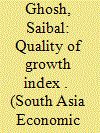

|
|
|
|
|
| Summary/Abstract |
Employing decadal data for the period 1971–2011, this article constructs a quality of growth index (QGI) for major Indian states. The index encompasses not only growth and its durability, but also encompasses several relevant social dimensions. These include variables such as stability and diversification of growth as well as institutional quality and social indicators such as life expectancy and literacy rate. The extended period chosen enables us to trace the evolution of the index over a sufficiently long period of time. Several findings stand out. First, the average value of the index is higher in the post-reform period, suggesting that there has been an overall improvement in the quality of growth over time. However, although the BIMAROU states have raised their QGI, they have still lagged behind their peers. Second, it is typically the industrialized states which have witnessed higher QGI. And third, the industrialized states, with improved financial access and better physical infrastructure, which are better placed are those with higher QGI.
|
|
|
|
|
|
|
|
|
|
|
|
|
|
|
|
| 7 |
ID:
143533
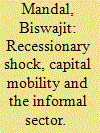

|
|
|
|
|
| Summary/Abstract |
Using the hybrid of Heckscher–Ohlin and Specific Factor models of trade, we show that the economic recession led to shock results for both capitalists and skilled workers. Some of the unionized unskilled workers lose formal sector employment and move onto the informal sector. When capital moves from the formal to the informal segments, both informal employment and wage can go up in latter’s segment. If capital does not move, informal employment expands and wage drops. Thus, recession may have actually benefitted a large number of informal workers.
|
|
|
|
|
|
|
|
|
|
|
|
|
|
|
|
| 8 |
ID:
143528


|
|
|
|
|
| Summary/Abstract |
This article undertakes a cost and benefit analysis of Afghanistan’s accession to World Trade Organization (WTO) while attempting to shed light on the post-accession challenges. For the empirical part of our analysis, we have applied the WITS/SMART model to assess the implication of WTO membership. The partial equilibrium model embedded in World Integrated Trade Solution (WITS) allows users to estimate the impact of tariff reductions on trade flows, tariff revenue, and consumer surplus for a single market at a time. Tariff cut is an independent variable, and government revenue, trade creation, consumer welfare and general welfare of the economy are the other variables. The results show that Afghanistan consumers stand to benefit from tariff reforms with overall positive welfare gains to the economy. However, a reduction in tariff will lead to a fall in government revenue and a substantial increase in imports which may raise some concerns over the negative trade balance. The last section of the article studies the post-accession challenges of WTO accession with a special focus on developmental, institutional, legal and environmental challenges. Our analysis based on the sectoral mix of Afghanistan’s economy suggests that producers will lose out. Findings of this study support the argument to maintain maximum policy space for Afghanistan for its long-term development need purposes.
|
|
|
|
|
|
|
|
|
|
|
|
|
|
|
|
|
|
|
|
|